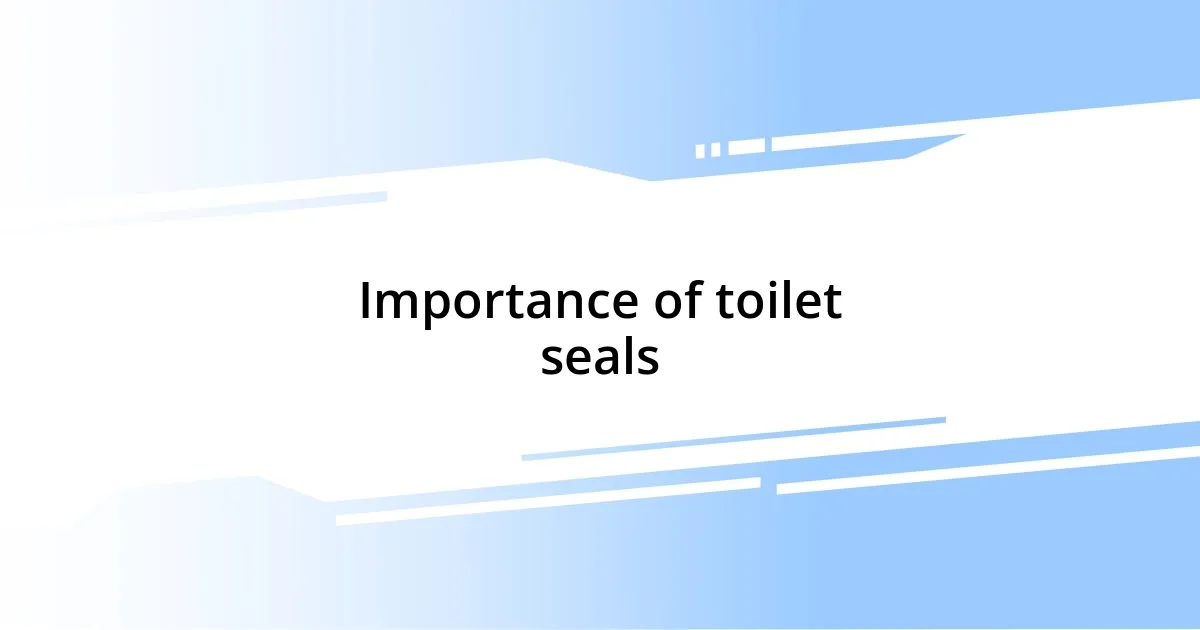Key takeaways:
- Toilet seals are essential for preventing leaks, maintaining hygiene, and protecting home structures from water damage.
- Different types of toilet seals include wax, wax-free, and foam, each with unique advantages such as ease of installation and durability.
- Signs of a faulty seal include unexpected wetness on the floor, unpleasant odors, and water pooling around the toilet base.
- Regular inspection and maintenance of toilet seals, including tightening bolts and using gentle cleaning solutions, can prolong their lifespan and prevent costly plumbing issues.

Understanding toilet seals
Toilet seals, often overlooked, are crucial for preventing leaks between the toilet base and the floor. A few years back, I experienced a minor water leak that turned into a bigger issue because the wax seal had deteriorated. It really made me appreciate how such a simple component plays a vital role in plumbing efficiency.
When I first learned about the different types of toilet seals—like wax, wax-free, and foam—I found it fascinating how each has its own unique advantages. Have you ever thought about how a simple wax ring can impact your home’s hygiene and sanitation? I remember feeling empowered when I decided to replace a wax seal myself. It was a bit messy, but knowing I was preventing water damage made it all worthwhile.
It’s essential to remember that toilet seals don’t last forever. Over time, they can degrade due to moisture, temperature changes, and the weight of the toilet itself. I often wonder how many people experience leaks without realizing the source is their toilet seal. It encourages me to check mine regularly and share that knowledge with friends—because nobody wants to deal with a surprise flood in their bathroom!

Types of toilet seals
When diving into the world of toilet seals, I quickly discovered that the most common type is the classic wax seal. It’s remarkable how this seemingly simple product can effectively create a watertight barrier. I remember the moment I decided to install one myself; the weight of the wax felt surprisingly reassuring. However, I also realized its vulnerability—it can crack, dry out, or compress, leading to leaks.
Wax-free seals are another interesting option I found while researching. They often come with a rubber or foam design that provides flexibility and durability. I appreciate this type because, during my last project, I noticed they’re easier to install and require far less cleanup than wax seals. Plus, the peace of mind that comes from knowing it can handle minor fluctuations in the floor’s shape is a huge bonus!
Foam toilet seals have recently caught my attention, too. They offer a unique advantage by compressing to create a secure fit around the toilet base. I vividly recall chatting with a friend who had switched to foam, and she couldn’t stop raving about how it eliminated the mess. This experience opened my eyes to how choosing the right seal isn’t just about practicality—it’s about enhancing our day-to-day comfort and reducing stress in home maintenance.
| Type of Seal | Advantages |
|---|---|
| Wax Seal | Reliable, watertight seal; economical |
| Wax-Free Seal | Easy installation; less mess |
| Foam Seal | Compresses for a snug fit; good for slightly uneven floors |

Importance of toilet seals
The importance of toilet seals really hit home for me when I faced a leaky situation that caught me completely off guard. Picture this: it was a quiet Saturday morning, and I stepped into the bathroom only to find a small puddle forming near the base of the toilet. It turned out that the seal had degraded over time, and I realized just how crucial it is to have a secure, functioning seal. It’s one of those things that, until you experience it firsthand, you may not appreciate fully.
Here are a few key reasons why toilet seals matter:
- Leak Prevention: They act as a barrier to prevent water from leaking into your home.
- Hygiene Maintenance: By sealing the toilet base, they help maintain a cleaner bathroom environment.
- Structural Protection: A good seal prevents water damage that can compromise the flooring and structure beneath the toilet.
- Cost-Effectiveness: Addressing seal issues early can save you significant repair costs in the long run.
I learned that failing to address seal degradation can lead to larger, more costly plumbing issues, and that’s a lesson I won’t forget anytime soon. Each time I step into my bathroom now, I’m reminded that a little piece of wax or rubber plays such an immense role in keeping my home safe and dry.

Signs of a faulty seal
Spotting a faulty toilet seal isn’t just about keeping the bathroom dry; it’s about peace of mind. One of the most telling signs for me was the unsettling feeling of slipping on wet bathroom tiles when there shouldn’t be any water present. That’s a red flag, right? If you’re experiencing that, I’d suggest checking around the base of your toilet—there might be some sneaky leaks at play.
Another telltale sign is the presence of unpleasant odors. I remember when I noticed a musty smell creeping up in my own bathroom. It turned out to be a consequence of trapped moisture due to a compromised seal. Have you ever faced something similar? You’d be surprised how a simple toilet seal can lead to other issues, like mold or mildew. It’s a reminder that we should never ignore those pesky odors; they could be trying to tell us something important.
Sometimes, you might even notice water pooling around the toilet’s base after using it. I recall a friend sharing her frustration after hosting a gathering, only to find a small puddle on her lovely bathroom floor. This seemingly insignificant issue is often shrugged off, but if left unchecked, it can escalate into something much worse. It’s crucial to take these signs seriously and not wait for water damage to spring up right in front of your eyes.

Maintenance tips for toilet seals
Regular maintenance of your toilet seal is key to preventing problems. I remember a time when I decided to inspect mine during my spring cleaning routine. With just a simple visual check for cracks or signs of wear, I felt empowered to tackle the issue before it spiraled into a bigger mess.
One maintenance tip that has served me well is incorporating a periodic tightening of the toilet bolts. I was surprised how often they can loosen over time. Have you ever felt that nervous itch in the pit of your stomach when hearing odd sounds from your bathroom? That anxiety could very well stem from an unsteady toilet, so a quick check might save you from unneeded stress.
Additionally, I discovered that using a gentle cleaning solution around the base can significantly prolong the life of your seal. Instead of harsh chemicals, I opted for a mix of vinegar and baking soda. It’s not just kind to the environment; it also keeps my bathroom fresh and free from build-up that could compromise that precious seal. Trust me, taking these small steps can make a big difference in maintaining an effective toilet seal.














